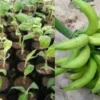- このトピックは空です。
- 投稿者投稿
- 3月 20, 2025 10:19 am #598217

From the sun-drenched orchards where tropical breezes whisper secrets of sweetness, comes a treasure trove of flavor and nutrition – the paw paw fruit.
This unassuming fruit, often overlooked, holds a wealth of benefits and culinary possibilities that deserve a spotlight. Let’s delve into the multifaceted world of this tropical delight, exploring its origins, nutritional profile, and diverse applications.
1. Origins And Cultivation
The paw paw, scientifically known as Asimina triloba, is a native fruit of eastern North America, a surprising fact given its tropical taste.
It’s the largest edible fruit indigenous to the continent. This fruit prefers a temperate climate and thrives in rich, well-drained soil.
Cultivating paw paws can be a patient endeavor, as they require cross-pollination to produce fruit and take several years to mature. They are often found in the understory of forests, mimicking their natural habitat.
Their unique, almost prehistoric appearance, with large, drooping leaves and fleshy fruit, adds to their allure.
2. Nutritional Powerhouse
The nutritional profile of the paw paw fruit is nothing short of impressive. It’s a rich source of vitamins and minerals, including vitamin C, potassium, magnesium, and iron.
It also provides significant amounts of antioxidants, which help combat free radicals in the body. Furthermore, paw paws contain essential amino acids, making them a valuable addition to a balanced diet.
The high fiber content contributes to digestive health, and the fruit’s natural sugars offer a healthy source of energy. This combination of nutrients makes the paw paw a true superfood, deserving of greater recognition.
3. Flavor And Texture
The taste of a ripe paw paw is often described as a blend of banana, mango, and pineapple, with a custard-like texture. This unique combination creates a delightful sensory experience, making it a versatile ingredient in various culinary applications.
The fruit’s flesh is soft and creamy, melting in the mouth with a subtly sweet and slightly tangy flavor. The aroma is equally enticing, often described as floral and tropical. The paw paw’s distinct flavor profile allows it to be used in both sweet and savory dishes, from desserts to sauces.
4. Culinary Versatility
The paw paw fruit lends itself to a wide range of culinary uses. It can be eaten fresh, straight from the tree, or incorporated into various recipes.
Paw paw pulp can be used to make smoothies, ice cream, and pies. It can also be added to baked goods, such as muffins and breads, for a tropical twist.
Furthermore, paw paw can be used to create jams, jellies, and preserves, capturing its unique flavor for year-round enjoyment. In savory dishes, paw paw can be used to create sauces and chutneys, adding a sweet and tangy element to meats and vegetables.
5. Potential Health Benefits
Beyond its nutritional value, the paw paw fruit has been studied for its potential health benefits. Research suggests that compounds found in paw paws may have anti-inflammatory and anti-cancer properties. Additionally, the fruit’s high antioxidant content may contribute to cardiovascular health and protect against oxidative stress.
Traditional medicine has also utilized paw paw for various ailments. While more research is needed to fully understand the extent of these benefits, the existing evidence highlights the paw paw’s potential as a valuable health-promoting food.
The unsung hero of the temperate forest, the paw paw fruit, offers a delightful blend of flavor, nutrition, and versatility.
From its humble origins to its potential health benefits, this tropical treasure deserves a place in our hearts and on our plates. It’s a reminder that sometimes, the most extraordinary delights are found in the most unexpected places, waiting to be discovered and appreciated.
- 投稿者投稿
- このトピックに返信するにはログインが必要です。






